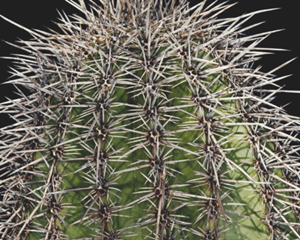The family Cactaceae, which evolved 35 million years ago in the Americas, is one of the most diverse and outlandish assemblages of plants on the planet.
仙人掌科是3500萬年前在美洲進化出來的,是全球多樣性最高、面貌也最光怪陸離的植物類群之一。
They can branch out as massive trees, rise as 60-foot-tall columns, grow as thick balloons, or fit on a one-cent coin.
它們可能像大樹一樣長出分枝,巍然聳立如18公尺高的巨柱,或長得像圓鼓鼓的氣球,或是小到能安放在一分錢硬幣上。
Some are "living rocks" able to handle soils that would desiccate any other plant, while others grow furry white coats to keep them from the elements in the cold Andean altitudes.
有些是“活巖石”,能應付會讓其他植物都脫水的土壤,有些還會長出白色絨毛,抵御在安地斯山脈寒冷高海拔地區的嚴寒。
None of those forms would exist if it weren't for a fundamental advancement: Cacti and other succulents have developed a unique approach to photosynthesis.
這些樣貌能夠存在,全是因為一個重大的進化:仙人掌和其他多肉植物發展出了一種獨特的光合作用形式。
Each time a plant opens its pores to take up the carbon dioxide necessary for energy conversion, some water is lost.
當植物打開氣孔、吸進轉換能量所需的二氧化碳時,都會失去一些水分。
If this happens frequently during daytime, high temperatures will cause the water to evaporate quickly.
如果這在白天頻繁發生,高溫就會讓水分迅速蒸發。
To prevent that, the desert plants don't open their pores until the sun goes down.
為了避免這種狀況,這些沙漠植物會等到太陽下山以后才打開氣孔。
Then they absorb atmospheric gas and convert it into malic acid, which is stored in large sacs inside their cells for use the next day.
然后它們會吸收大氣中的二氧化碳,轉化成蘋果酸、儲存在細胞內的大囊泡中,準備第二天使用。
It's a process called crassulacean acid metabolism, or CAM.
這個過程稱為景天酸代謝(CAM)。

John Cushman, a professor of biochemistry and molecular biology at the University of Nevada in Reno, dreams of cultivating this genetic trait in more plants.
約翰·庫希曼是內華達大學雷諾分校的生化與分子生物學家,他夢想著在更多植物身上培育出這個遺傳特征。
On the agricultural front, this could lead to more efficient crops that lose less water under drought conditions.
在農業上,這能造就更有效率的作物,碰到干旱狀況時損失的水會減少很多。
While that breakthrough may be years or even decades away, researchers have still found one way to make non-cactus plants be at least a little more cactus-like.
雖說這樣的突破可能還要等好幾年、甚至好幾十年,但研究人員已經找到了一種方法,讓非仙人掌植物至少更像仙人掌那么一點點。
Before cultivating CAM in new plants, scientists need to alter their leaf anatomy to store malic acid and accommodate larger cells, the processing warehouses for this interaction.
要讓新植物獲得CAM能力,科學家必須先改變這些植物的葉片構造,以儲存蘋果酸并容納較大的細胞,也就是這種交互作用的加工倉庫。
One by-product is that plants with larger cells can also hold more water, encouraging succulence, or the ability for their tissues to grow bigger and retain more available moisture.
其中一項副產品就是具有較大細胞的植物也能儲存較多水分,這會促進肉質性,也就是能讓植物組織長得更大、保留更多可用水分。
In a 2018 paper, Cushman demonstrated engineering tissue succulence in a small, white-flowered weed called mouse-ear cress (Arabidopsis thaliana).
在2018年的論文中,庫希曼示范了在一種名為阿拉伯芥的小型白花野草上改造出肉質組織。
A follow-up study, published in 2020, shows that the leaves of an experimental plant grew 40 percent thicker.
在2020年發表的一篇后續研究中則顯示某株實驗植物的葉片厚度增加了40%。
"It's an exciting adaptation that we still have a lot to learn from," says Cushman.
“這種適應成果令人振奮,我們能從中學習的還有很多,”庫希曼說。
For one thing, if a plant can expand the amount of water that it carries within its tissues, it can likely dilute the excessive salts that tend to concentrate in the soil during drought periods.
其一,如果植物能增加自身組織可容納的水分,或許就能稀釋干旱期問聚積在土壤中的多余鹽分。
Cushman is applying this science to soybeans, the second largest commodity crop in the U.S., in hopes of radically improving food security.
庫希曼已經把這項科學原理應用在美國第二大的商業作物黃豆上,希望能大幅改善糧食安全。












